Managerial Accounting - Seek Limited
VerifiedAdded on 2021/06/15
|19
|3745
|32
AI Summary
Contribute Materials
Your contribution can guide someone’s learning journey. Share your
documents today.
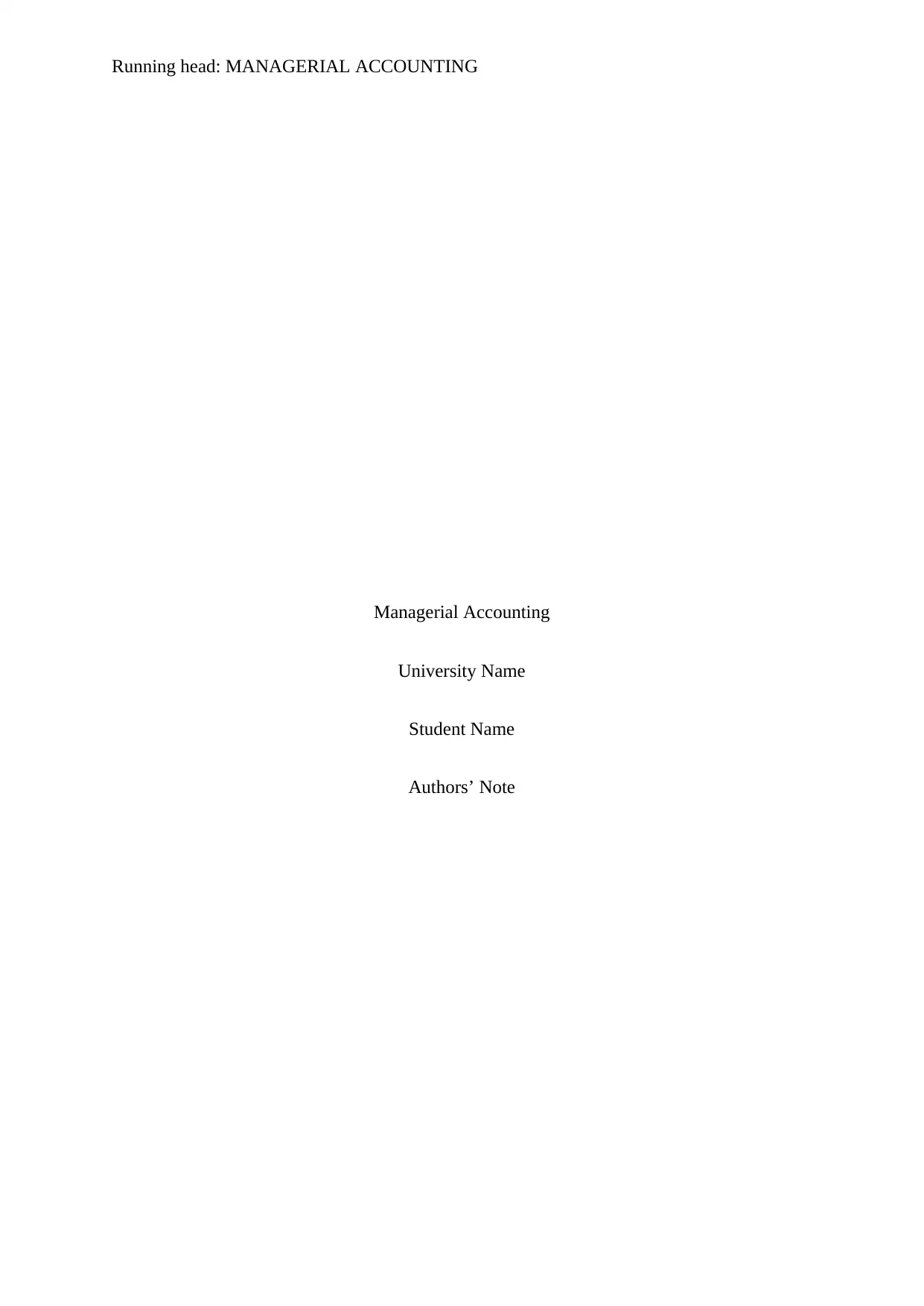
Running head: MANAGERIAL ACCOUNTING
Managerial Accounting
University Name
Student Name
Authors’ Note
Managerial Accounting
University Name
Student Name
Authors’ Note
Secure Best Marks with AI Grader
Need help grading? Try our AI Grader for instant feedback on your assignments.

2MANAGERIAL ACCOUNTING
Introduction
The current study elucidates illustratively remuneration scheme with special reference to the
operations of the firm SEEK. Seek Limited s well as its subsidiary companies, referred to as
the Seek Group, concentrate on helping the match between particularly jobseekers along with
employment chances and assisting hirers get candidates for different roles. This study
presents structure of remuneration committee along with its memberships and delivers
critically analysis of remuneration. This can help in understanding the way approach of the
company helped in inspiring higher performance by particularly the executive team and take
into account if this can be translated to superior performance of the company. Again, analysis
of allocation executive remuneration is also presented for the SEEK that takes in fixed pay,
short term incentive plan as well as the long term incentive plan. The research also explicates
with reference to the operations of the firm SEEK the mix of performance dimensions used.
Particularly, this can again be utilized to take into account the use of financial performance
dimensions as well as non –financial performance dimensions. Moreover, this study also
reports about any kind of alterations in the executive remuneration report of the firm SEEK.
Moving further, the study effectively presents the recommendations supported by the
academic literature on the subject matter under consideration. Also, the study also explains
the way the company might perhaps enhance the process of reporting or else broaden their
performance dimensions.
Summary of findings
Remuneration Committee and its memberships of the firm SEEK
Analysis of the annual report of the firm “SEEK” reveals the fact that objective of the
remuneration framework of the firm is to attract and to same time retain different talented
executives and keep them in line to build long term value of shareholders (Hooghiemstra et
Introduction
The current study elucidates illustratively remuneration scheme with special reference to the
operations of the firm SEEK. Seek Limited s well as its subsidiary companies, referred to as
the Seek Group, concentrate on helping the match between particularly jobseekers along with
employment chances and assisting hirers get candidates for different roles. This study
presents structure of remuneration committee along with its memberships and delivers
critically analysis of remuneration. This can help in understanding the way approach of the
company helped in inspiring higher performance by particularly the executive team and take
into account if this can be translated to superior performance of the company. Again, analysis
of allocation executive remuneration is also presented for the SEEK that takes in fixed pay,
short term incentive plan as well as the long term incentive plan. The research also explicates
with reference to the operations of the firm SEEK the mix of performance dimensions used.
Particularly, this can again be utilized to take into account the use of financial performance
dimensions as well as non –financial performance dimensions. Moreover, this study also
reports about any kind of alterations in the executive remuneration report of the firm SEEK.
Moving further, the study effectively presents the recommendations supported by the
academic literature on the subject matter under consideration. Also, the study also explains
the way the company might perhaps enhance the process of reporting or else broaden their
performance dimensions.
Summary of findings
Remuneration Committee and its memberships of the firm SEEK
Analysis of the annual report of the firm “SEEK” reveals the fact that objective of the
remuneration framework of the firm is to attract and to same time retain different talented
executives and keep them in line to build long term value of shareholders (Hooghiemstra et
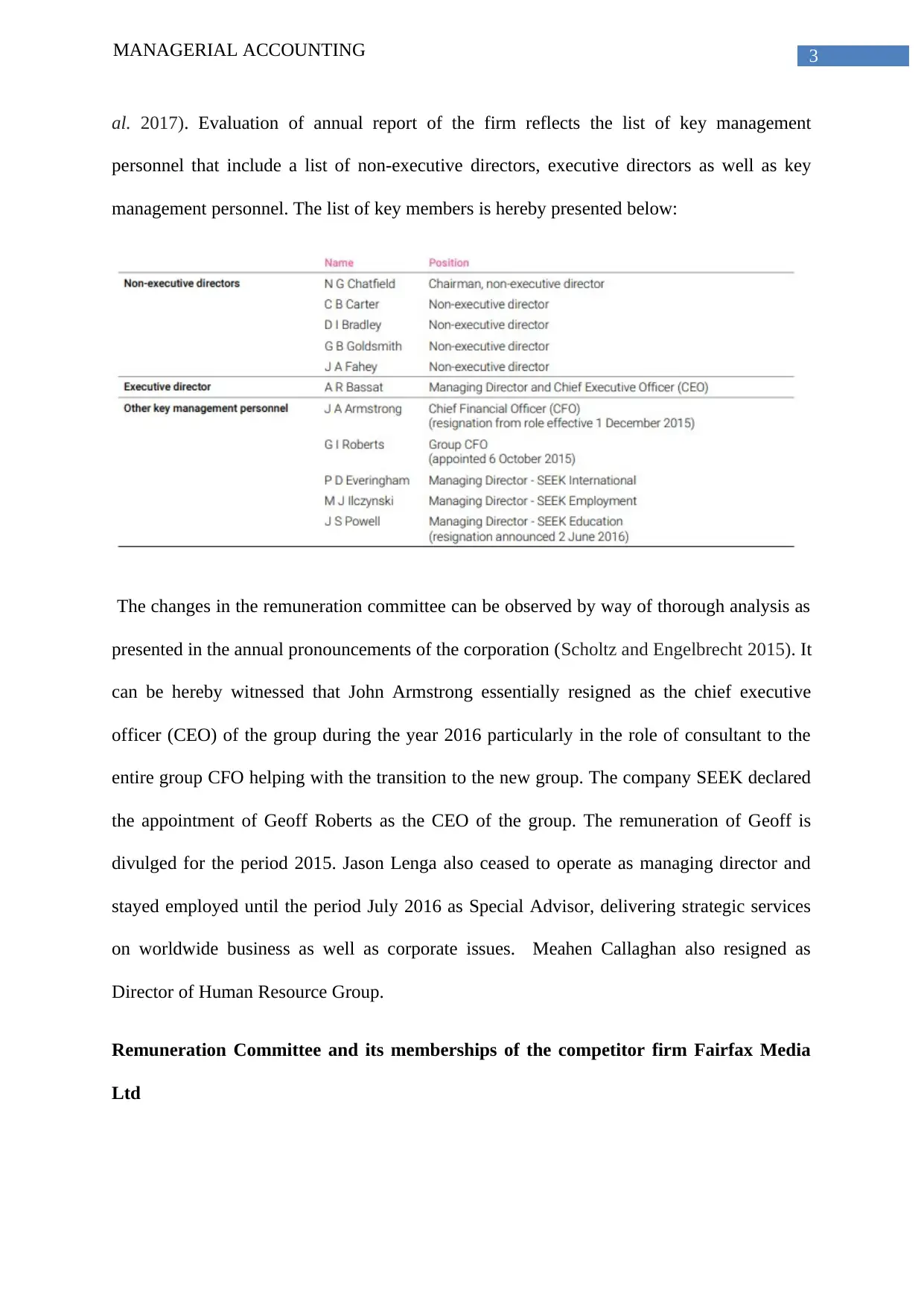
3MANAGERIAL ACCOUNTING
al. 2017). Evaluation of annual report of the firm reflects the list of key management
personnel that include a list of non-executive directors, executive directors as well as key
management personnel. The list of key members is hereby presented below:
The changes in the remuneration committee can be observed by way of thorough analysis as
presented in the annual pronouncements of the corporation (Scholtz and Engelbrecht 2015). It
can be hereby witnessed that John Armstrong essentially resigned as the chief executive
officer (CEO) of the group during the year 2016 particularly in the role of consultant to the
entire group CFO helping with the transition to the new group. The company SEEK declared
the appointment of Geoff Roberts as the CEO of the group. The remuneration of Geoff is
divulged for the period 2015. Jason Lenga also ceased to operate as managing director and
stayed employed until the period July 2016 as Special Advisor, delivering strategic services
on worldwide business as well as corporate issues. Meahen Callaghan also resigned as
Director of Human Resource Group.
Remuneration Committee and its memberships of the competitor firm Fairfax Media
Ltd
al. 2017). Evaluation of annual report of the firm reflects the list of key management
personnel that include a list of non-executive directors, executive directors as well as key
management personnel. The list of key members is hereby presented below:
The changes in the remuneration committee can be observed by way of thorough analysis as
presented in the annual pronouncements of the corporation (Scholtz and Engelbrecht 2015). It
can be hereby witnessed that John Armstrong essentially resigned as the chief executive
officer (CEO) of the group during the year 2016 particularly in the role of consultant to the
entire group CFO helping with the transition to the new group. The company SEEK declared
the appointment of Geoff Roberts as the CEO of the group. The remuneration of Geoff is
divulged for the period 2015. Jason Lenga also ceased to operate as managing director and
stayed employed until the period July 2016 as Special Advisor, delivering strategic services
on worldwide business as well as corporate issues. Meahen Callaghan also resigned as
Director of Human Resource Group.
Remuneration Committee and its memberships of the competitor firm Fairfax Media
Ltd

4MANAGERIAL ACCOUNTING
The remuneration arrangement of the entire Fairfax Media is as per the regulations of Key
Management Personnel that is presented according to the Corporations Act of the year 2001
(Bian 2016). The composition of the competitor firm is as presented below:
Remuneration strategy of the main firm SEEK
Remuneration strategy of the firm is aligned to the purpose as well as vision of the company.
Essentially, 50% of executive remuneration is necessarily in cash as base salary as well as
superannuation (Cassim and Madlela 2017). In essence, this is established at specific levels
that attract the people to operate in different market conditions as well as economic cycles
(Riaz et al. 2015). Primarily, 50% of executive remuneration is particularly in equity, having
25% in rights for equity and 25% in LTI options. The components of LTI has essentially
three year vesting period and is particularly locked up for particularly 12 months. Executives
are in essence subject to minimum necessity of shareholding. Given the emphasis on mainly
The remuneration arrangement of the entire Fairfax Media is as per the regulations of Key
Management Personnel that is presented according to the Corporations Act of the year 2001
(Bian 2016). The composition of the competitor firm is as presented below:
Remuneration strategy of the main firm SEEK
Remuneration strategy of the firm is aligned to the purpose as well as vision of the company.
Essentially, 50% of executive remuneration is necessarily in cash as base salary as well as
superannuation (Cassim and Madlela 2017). In essence, this is established at specific levels
that attract the people to operate in different market conditions as well as economic cycles
(Riaz et al. 2015). Primarily, 50% of executive remuneration is particularly in equity, having
25% in rights for equity and 25% in LTI options. The components of LTI has essentially
three year vesting period and is particularly locked up for particularly 12 months. Executives
are in essence subject to minimum necessity of shareholding. Given the emphasis on mainly
Secure Best Marks with AI Grader
Need help grading? Try our AI Grader for instant feedback on your assignments.
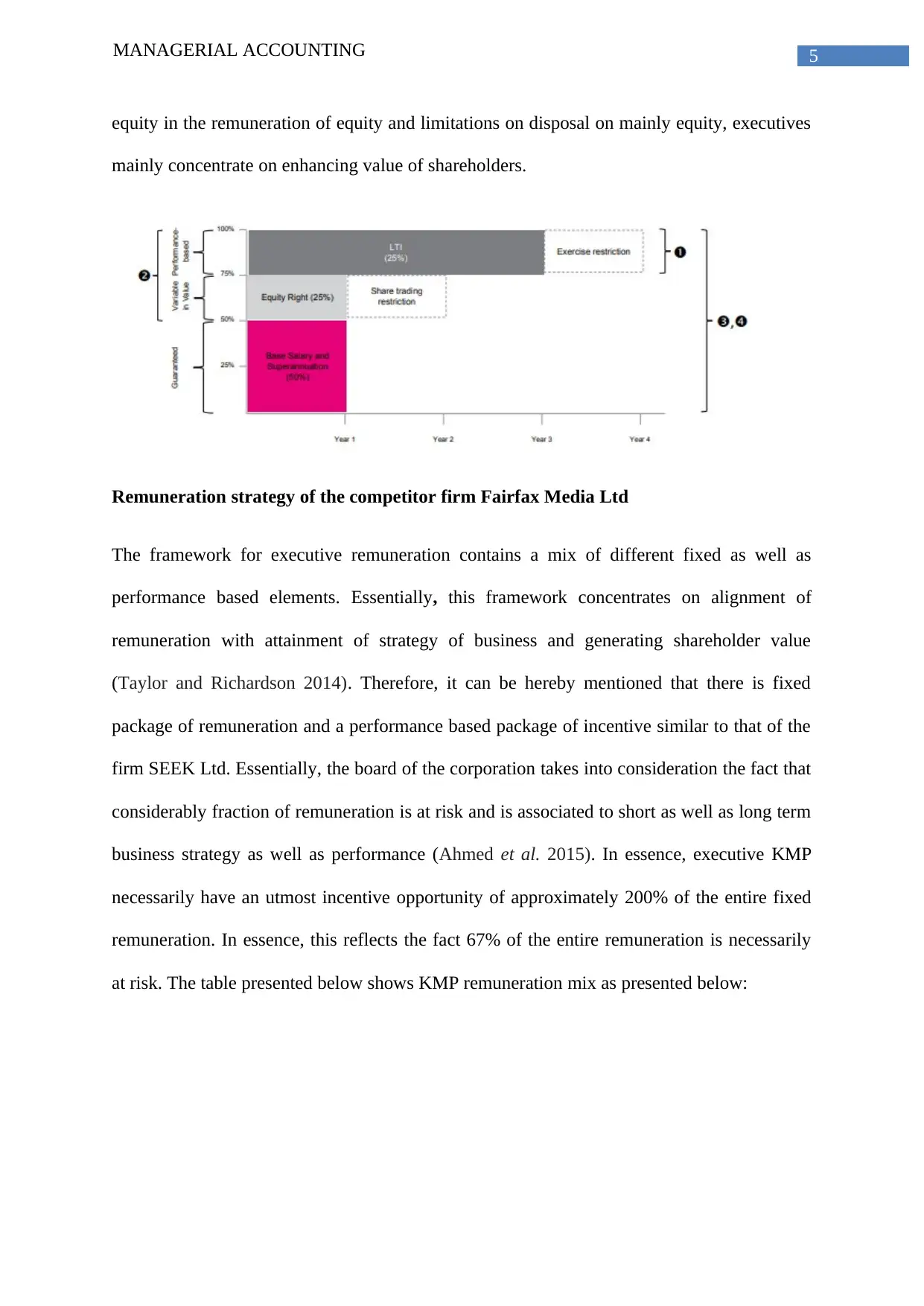
5MANAGERIAL ACCOUNTING
equity in the remuneration of equity and limitations on disposal on mainly equity, executives
mainly concentrate on enhancing value of shareholders.
Remuneration strategy of the competitor firm Fairfax Media Ltd
The framework for executive remuneration contains a mix of different fixed as well as
performance based elements. Essentially, this framework concentrates on alignment of
remuneration with attainment of strategy of business and generating shareholder value
(Taylor and Richardson 2014). Therefore, it can be hereby mentioned that there is fixed
package of remuneration and a performance based package of incentive similar to that of the
firm SEEK Ltd. Essentially, the board of the corporation takes into consideration the fact that
considerably fraction of remuneration is at risk and is associated to short as well as long term
business strategy as well as performance (Ahmed et al. 2015). In essence, executive KMP
necessarily have an utmost incentive opportunity of approximately 200% of the entire fixed
remuneration. In essence, this reflects the fact 67% of the entire remuneration is necessarily
at risk. The table presented below shows KMP remuneration mix as presented below:
equity in the remuneration of equity and limitations on disposal on mainly equity, executives
mainly concentrate on enhancing value of shareholders.
Remuneration strategy of the competitor firm Fairfax Media Ltd
The framework for executive remuneration contains a mix of different fixed as well as
performance based elements. Essentially, this framework concentrates on alignment of
remuneration with attainment of strategy of business and generating shareholder value
(Taylor and Richardson 2014). Therefore, it can be hereby mentioned that there is fixed
package of remuneration and a performance based package of incentive similar to that of the
firm SEEK Ltd. Essentially, the board of the corporation takes into consideration the fact that
considerably fraction of remuneration is at risk and is associated to short as well as long term
business strategy as well as performance (Ahmed et al. 2015). In essence, executive KMP
necessarily have an utmost incentive opportunity of approximately 200% of the entire fixed
remuneration. In essence, this reflects the fact 67% of the entire remuneration is necessarily
at risk. The table presented below shows KMP remuneration mix as presented below:
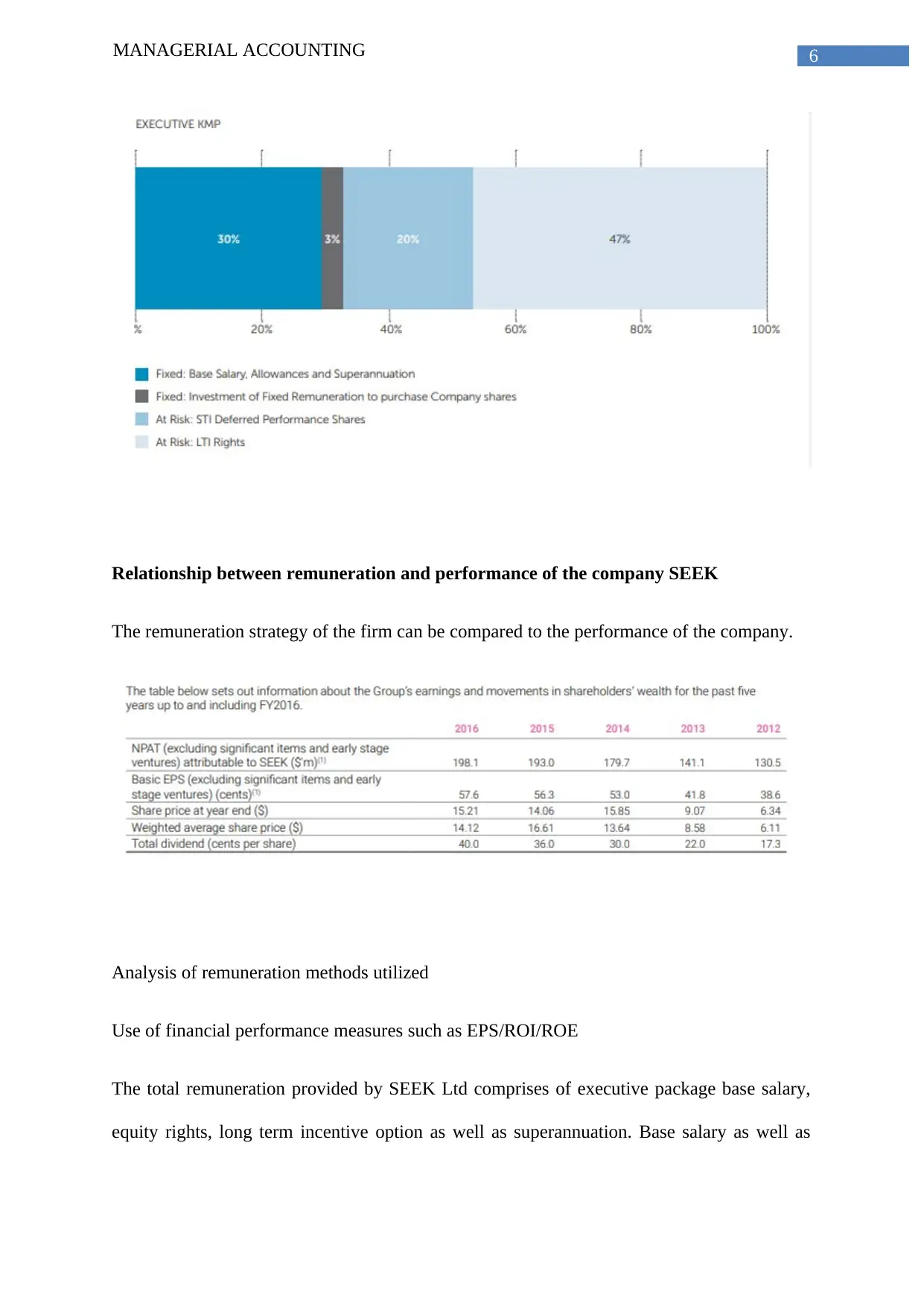
6MANAGERIAL ACCOUNTING
Relationship between remuneration and performance of the company SEEK
The remuneration strategy of the firm can be compared to the performance of the company.
Analysis of remuneration methods utilized
Use of financial performance measures such as EPS/ROI/ROE
The total remuneration provided by SEEK Ltd comprises of executive package base salary,
equity rights, long term incentive option as well as superannuation. Base salary as well as
Relationship between remuneration and performance of the company SEEK
The remuneration strategy of the firm can be compared to the performance of the company.
Analysis of remuneration methods utilized
Use of financial performance measures such as EPS/ROI/ROE
The total remuneration provided by SEEK Ltd comprises of executive package base salary,
equity rights, long term incentive option as well as superannuation. Base salary as well as
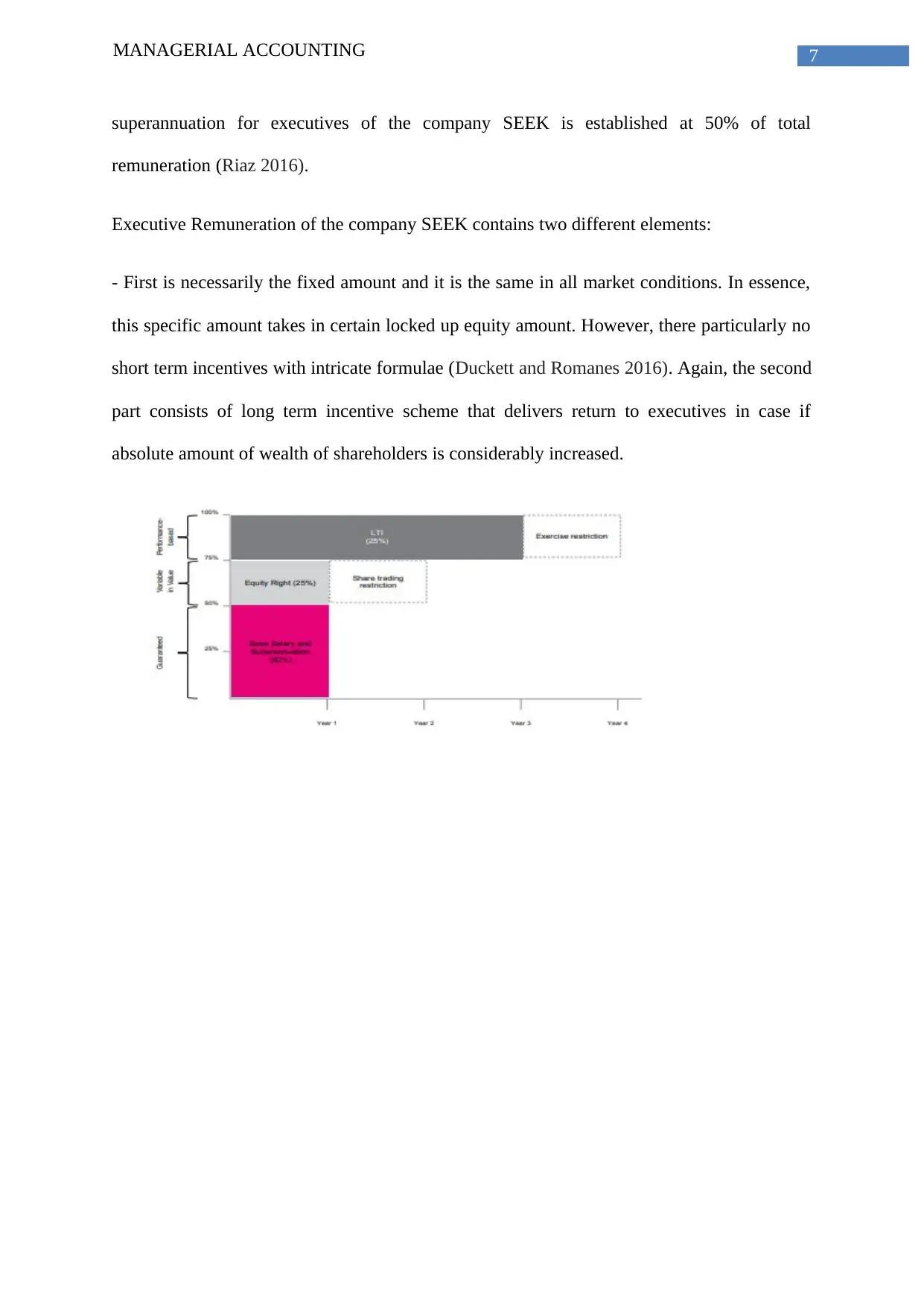
7MANAGERIAL ACCOUNTING
superannuation for executives of the company SEEK is established at 50% of total
remuneration (Riaz 2016).
Executive Remuneration of the company SEEK contains two different elements:
- First is necessarily the fixed amount and it is the same in all market conditions. In essence,
this specific amount takes in certain locked up equity amount. However, there particularly no
short term incentives with intricate formulae (Duckett and Romanes 2016). Again, the second
part consists of long term incentive scheme that delivers return to executives in case if
absolute amount of wealth of shareholders is considerably increased.
superannuation for executives of the company SEEK is established at 50% of total
remuneration (Riaz 2016).
Executive Remuneration of the company SEEK contains two different elements:
- First is necessarily the fixed amount and it is the same in all market conditions. In essence,
this specific amount takes in certain locked up equity amount. However, there particularly no
short term incentives with intricate formulae (Duckett and Romanes 2016). Again, the second
part consists of long term incentive scheme that delivers return to executives in case if
absolute amount of wealth of shareholders is considerably increased.
Paraphrase This Document
Need a fresh take? Get an instant paraphrase of this document with our AI Paraphraser
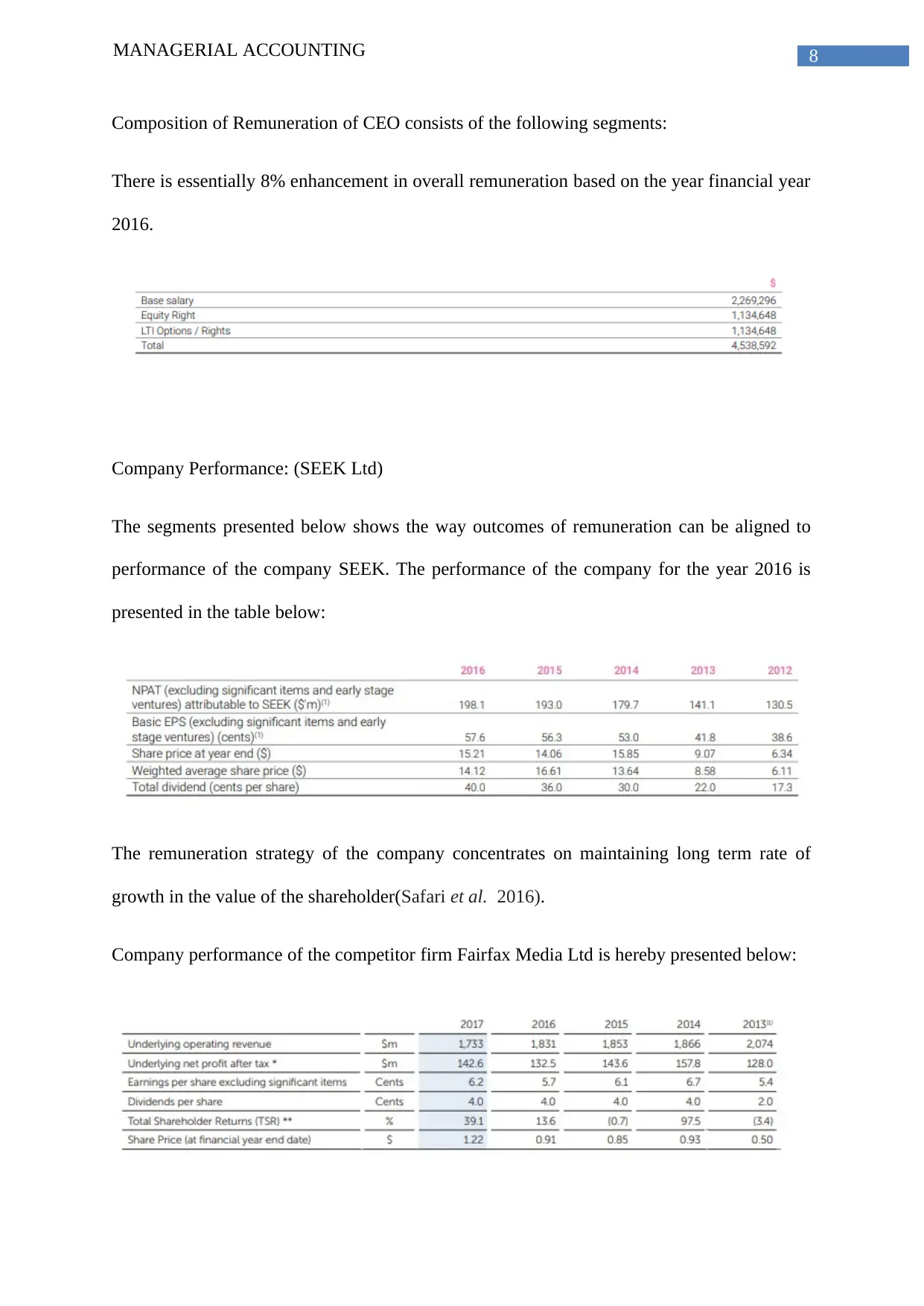
8MANAGERIAL ACCOUNTING
Composition of Remuneration of CEO consists of the following segments:
There is essentially 8% enhancement in overall remuneration based on the year financial year
2016.
Company Performance: (SEEK Ltd)
The segments presented below shows the way outcomes of remuneration can be aligned to
performance of the company SEEK. The performance of the company for the year 2016 is
presented in the table below:
The remuneration strategy of the company concentrates on maintaining long term rate of
growth in the value of the shareholder(Safari et al. 2016).
Company performance of the competitor firm Fairfax Media Ltd is hereby presented below:
Composition of Remuneration of CEO consists of the following segments:
There is essentially 8% enhancement in overall remuneration based on the year financial year
2016.
Company Performance: (SEEK Ltd)
The segments presented below shows the way outcomes of remuneration can be aligned to
performance of the company SEEK. The performance of the company for the year 2016 is
presented in the table below:
The remuneration strategy of the company concentrates on maintaining long term rate of
growth in the value of the shareholder(Safari et al. 2016).
Company performance of the competitor firm Fairfax Media Ltd is hereby presented below:
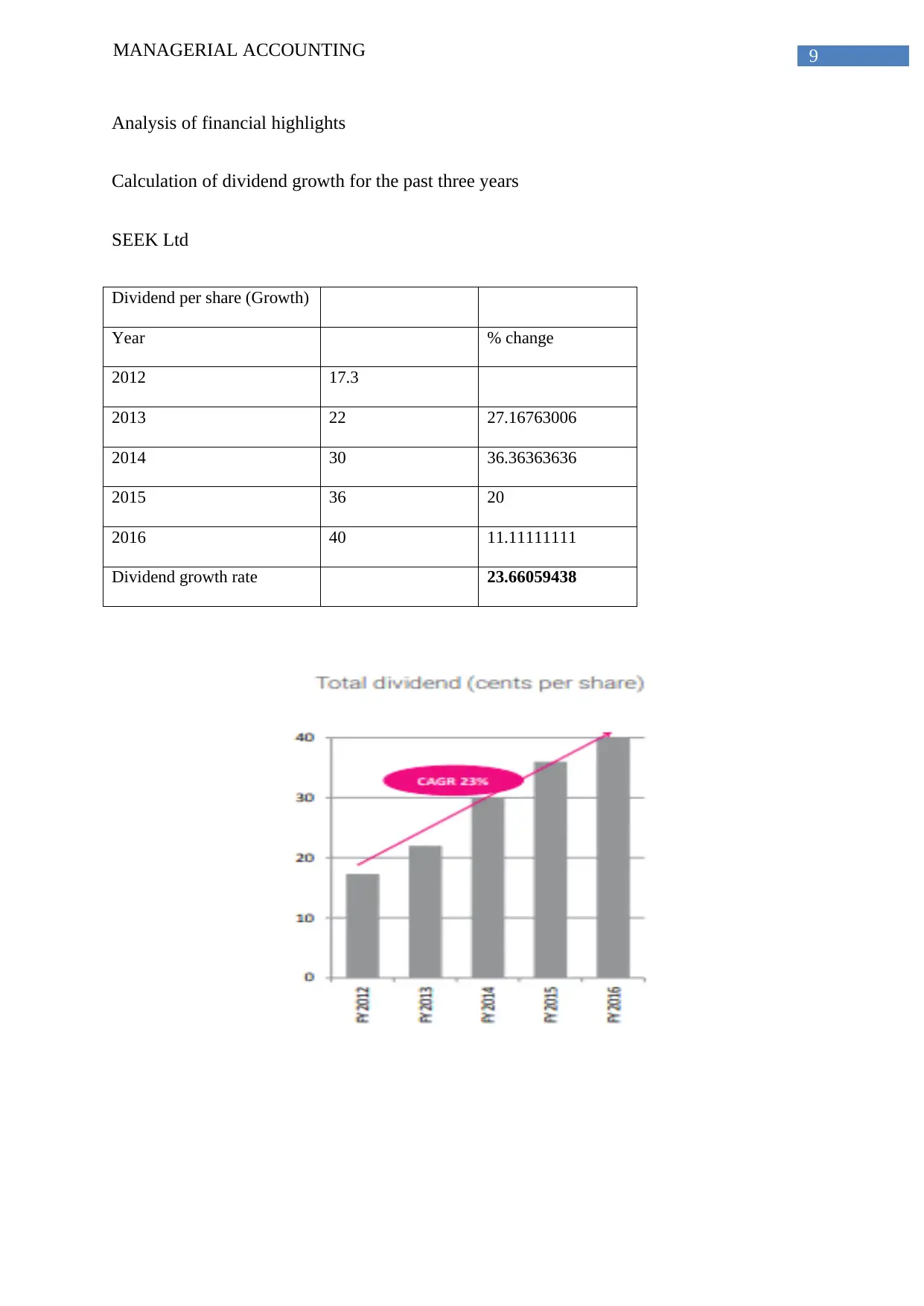
9MANAGERIAL ACCOUNTING
Analysis of financial highlights
Calculation of dividend growth for the past three years
SEEK Ltd
Dividend per share (Growth)
Year % change
2012 17.3
2013 22 27.16763006
2014 30 36.36363636
2015 36 20
2016 40 11.11111111
Dividend growth rate 23.66059438
Analysis of financial highlights
Calculation of dividend growth for the past three years
SEEK Ltd
Dividend per share (Growth)
Year % change
2012 17.3
2013 22 27.16763006
2014 30 36.36363636
2015 36 20
2016 40 11.11111111
Dividend growth rate 23.66059438
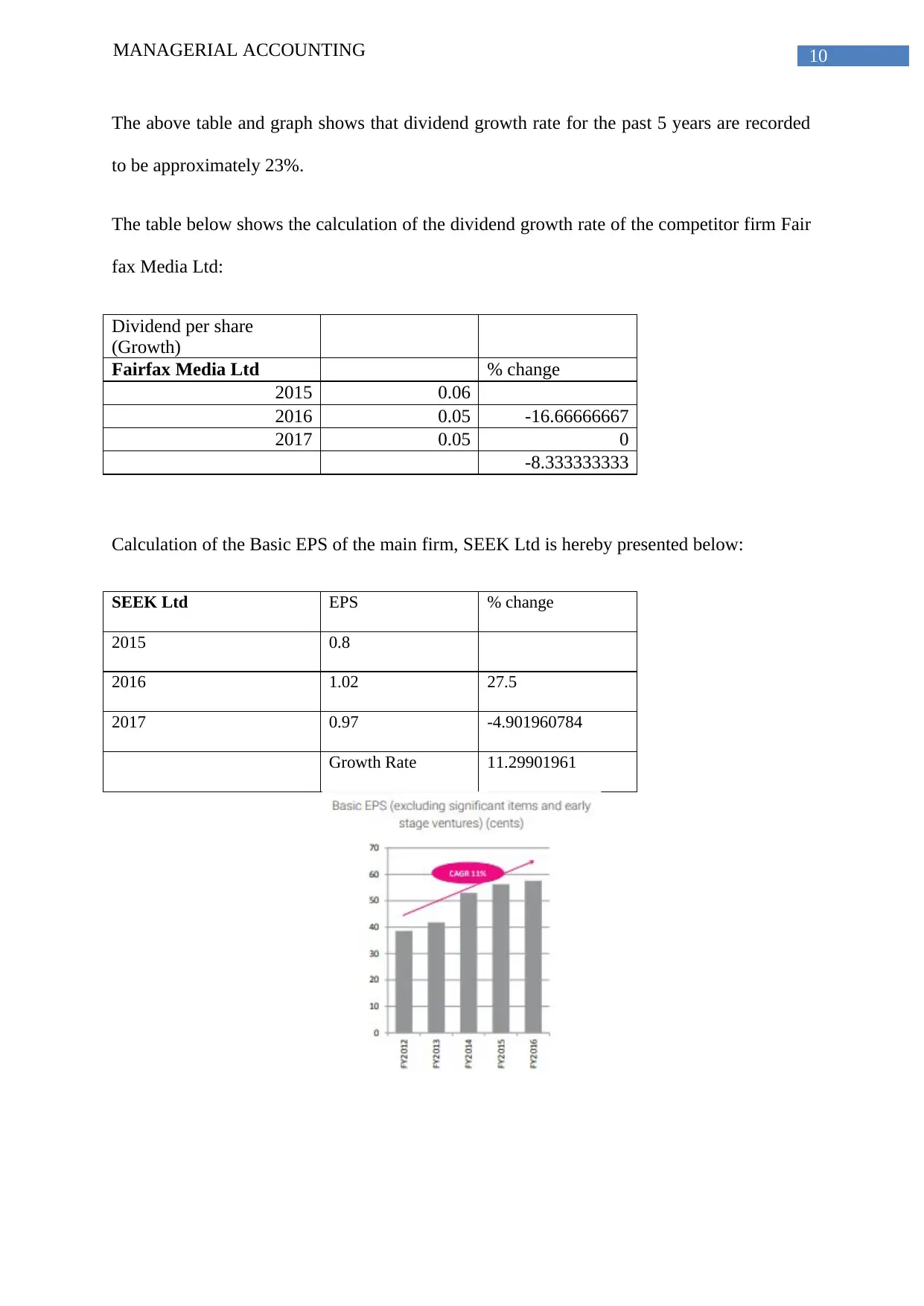
10MANAGERIAL ACCOUNTING
The above table and graph shows that dividend growth rate for the past 5 years are recorded
to be approximately 23%.
The table below shows the calculation of the dividend growth rate of the competitor firm Fair
fax Media Ltd:
Dividend per share
(Growth)
Fairfax Media Ltd % change
2015 0.06
2016 0.05 -16.66666667
2017 0.05 0
-8.333333333
Calculation of the Basic EPS of the main firm, SEEK Ltd is hereby presented below:
SEEK Ltd EPS % change
2015 0.8
2016 1.02 27.5
2017 0.97 -4.901960784
Growth Rate 11.29901961
The above table and graph shows that dividend growth rate for the past 5 years are recorded
to be approximately 23%.
The table below shows the calculation of the dividend growth rate of the competitor firm Fair
fax Media Ltd:
Dividend per share
(Growth)
Fairfax Media Ltd % change
2015 0.06
2016 0.05 -16.66666667
2017 0.05 0
-8.333333333
Calculation of the Basic EPS of the main firm, SEEK Ltd is hereby presented below:
SEEK Ltd EPS % change
2015 0.8
2016 1.02 27.5
2017 0.97 -4.901960784
Growth Rate 11.29901961
Secure Best Marks with AI Grader
Need help grading? Try our AI Grader for instant feedback on your assignments.
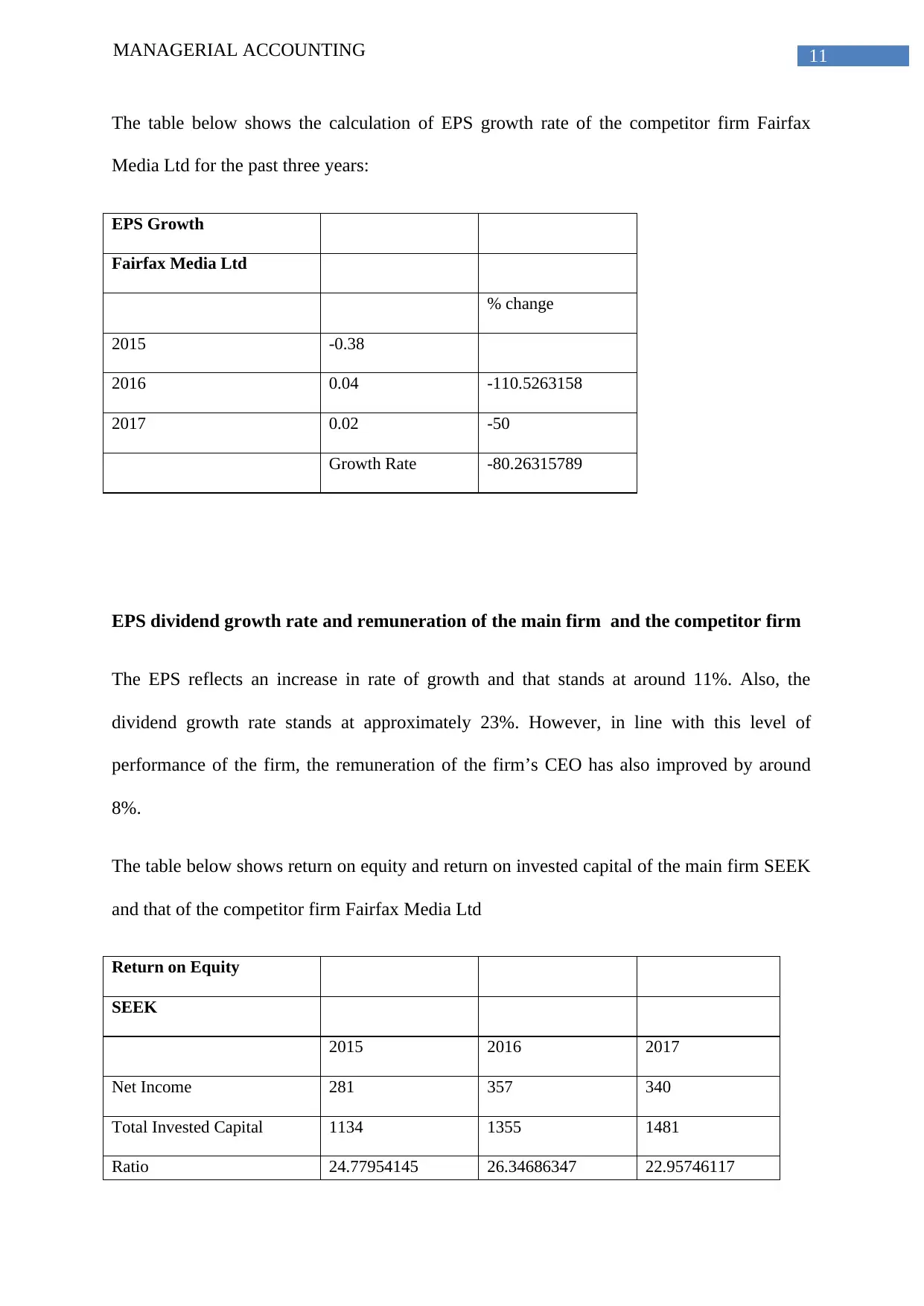
11MANAGERIAL ACCOUNTING
The table below shows the calculation of EPS growth rate of the competitor firm Fairfax
Media Ltd for the past three years:
EPS Growth
Fairfax Media Ltd
% change
2015 -0.38
2016 0.04 -110.5263158
2017 0.02 -50
Growth Rate -80.26315789
EPS dividend growth rate and remuneration of the main firm and the competitor firm
The EPS reflects an increase in rate of growth and that stands at around 11%. Also, the
dividend growth rate stands at approximately 23%. However, in line with this level of
performance of the firm, the remuneration of the firm’s CEO has also improved by around
8%.
The table below shows return on equity and return on invested capital of the main firm SEEK
and that of the competitor firm Fairfax Media Ltd
Return on Equity
SEEK
2015 2016 2017
Net Income 281 357 340
Total Invested Capital 1134 1355 1481
Ratio 24.77954145 26.34686347 22.95746117
The table below shows the calculation of EPS growth rate of the competitor firm Fairfax
Media Ltd for the past three years:
EPS Growth
Fairfax Media Ltd
% change
2015 -0.38
2016 0.04 -110.5263158
2017 0.02 -50
Growth Rate -80.26315789
EPS dividend growth rate and remuneration of the main firm and the competitor firm
The EPS reflects an increase in rate of growth and that stands at around 11%. Also, the
dividend growth rate stands at approximately 23%. However, in line with this level of
performance of the firm, the remuneration of the firm’s CEO has also improved by around
8%.
The table below shows return on equity and return on invested capital of the main firm SEEK
and that of the competitor firm Fairfax Media Ltd
Return on Equity
SEEK
2015 2016 2017
Net Income 281 357 340
Total Invested Capital 1134 1355 1481
Ratio 24.77954145 26.34686347 22.95746117
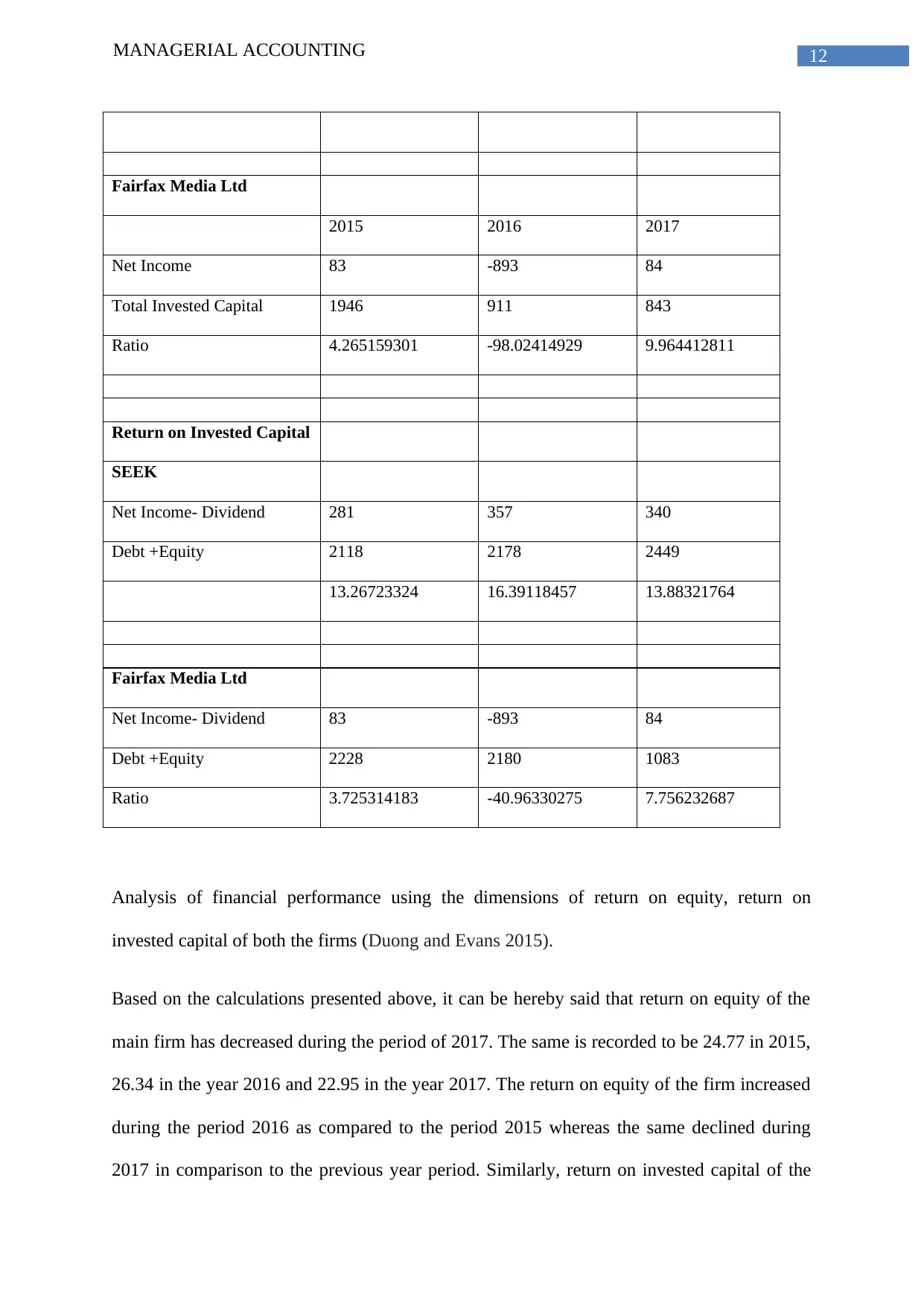
12MANAGERIAL ACCOUNTING
Fairfax Media Ltd
2015 2016 2017
Net Income 83 -893 84
Total Invested Capital 1946 911 843
Ratio 4.265159301 -98.02414929 9.964412811
Return on Invested Capital
SEEK
Net Income- Dividend 281 357 340
Debt +Equity 2118 2178 2449
13.26723324 16.39118457 13.88321764
Fairfax Media Ltd
Net Income- Dividend 83 -893 84
Debt +Equity 2228 2180 1083
Ratio 3.725314183 -40.96330275 7.756232687
Analysis of financial performance using the dimensions of return on equity, return on
invested capital of both the firms (Duong and Evans 2015).
Based on the calculations presented above, it can be hereby said that return on equity of the
main firm has decreased during the period of 2017. The same is recorded to be 24.77 in 2015,
26.34 in the year 2016 and 22.95 in the year 2017. The return on equity of the firm increased
during the period 2016 as compared to the period 2015 whereas the same declined during
2017 in comparison to the previous year period. Similarly, return on invested capital of the
Fairfax Media Ltd
2015 2016 2017
Net Income 83 -893 84
Total Invested Capital 1946 911 843
Ratio 4.265159301 -98.02414929 9.964412811
Return on Invested Capital
SEEK
Net Income- Dividend 281 357 340
Debt +Equity 2118 2178 2449
13.26723324 16.39118457 13.88321764
Fairfax Media Ltd
Net Income- Dividend 83 -893 84
Debt +Equity 2228 2180 1083
Ratio 3.725314183 -40.96330275 7.756232687
Analysis of financial performance using the dimensions of return on equity, return on
invested capital of both the firms (Duong and Evans 2015).
Based on the calculations presented above, it can be hereby said that return on equity of the
main firm has decreased during the period of 2017. The same is recorded to be 24.77 in 2015,
26.34 in the year 2016 and 22.95 in the year 2017. The return on equity of the firm increased
during the period 2016 as compared to the period 2015 whereas the same declined during
2017 in comparison to the previous year period. Similarly, return on invested capital of the

13MANAGERIAL ACCOUNTING
firm SEEK is observe to have increased to 16.39 during the period 2016 in comparison to
13.26 during the year 2015. However, the same is said to have declined in the year 2017 to
13.88 as comparison to 16.39 in the year 2016. Thus, this decline can be considered to be an
unfavourable financial condition for the firm (Grosse et al. 2017).
On the other hand, the financial performance of the competitor firm (Fairfax Media Ltd) can
be compared with that of the main firm for the specified period. The return on equity of the
competitor firm initially declined to approximately 98% in 2016 in comparison to 4.2% in the
year 2015. However, the same increased to 9.96% during the period 2017. This implies that
return on equity of the firm improved implying favourable financial condition of the
corporation (Windsor et al. 2017). Analysis of return on equity replicates that the firm SEEK
has significantly higher return equity (in percentage) in comparison to the competitor firm
Fairfax Media Ltd. However, the return on equity is considered to be the highest for the firm
SEEK during the period 2016.
Based on the enumerations of return on invested capital of the main firm SEEK it can be
hereby said that return on invested capital increased to 16.39 in the year 2016 in comparison
to 13.26 in the year 2015. This reflects improved financial condition for the firm replicating
higher efficiency of the firm to acquire higher amount of capital (Pottenger and Leigh2016).
Nonetheless, the same declined during the period 2017 reflecting extremely undesirable
financial condition. On the other hand, the Return on investment capital for the competitor
firm Fairfax Media Ltd increased during the period 2017 in comparison to the year 2016.
Analysis of financial condition of the firm replicates the fact that SEEK has a considerably
better financial condition in comparison to Fairfax Media particularly during the current
period of 2017 in terms of both return on both equity as well as return on invested capital (Fu
et al. 2015).
firm SEEK is observe to have increased to 16.39 during the period 2016 in comparison to
13.26 during the year 2015. However, the same is said to have declined in the year 2017 to
13.88 as comparison to 16.39 in the year 2016. Thus, this decline can be considered to be an
unfavourable financial condition for the firm (Grosse et al. 2017).
On the other hand, the financial performance of the competitor firm (Fairfax Media Ltd) can
be compared with that of the main firm for the specified period. The return on equity of the
competitor firm initially declined to approximately 98% in 2016 in comparison to 4.2% in the
year 2015. However, the same increased to 9.96% during the period 2017. This implies that
return on equity of the firm improved implying favourable financial condition of the
corporation (Windsor et al. 2017). Analysis of return on equity replicates that the firm SEEK
has significantly higher return equity (in percentage) in comparison to the competitor firm
Fairfax Media Ltd. However, the return on equity is considered to be the highest for the firm
SEEK during the period 2016.
Based on the enumerations of return on invested capital of the main firm SEEK it can be
hereby said that return on invested capital increased to 16.39 in the year 2016 in comparison
to 13.26 in the year 2015. This reflects improved financial condition for the firm replicating
higher efficiency of the firm to acquire higher amount of capital (Pottenger and Leigh2016).
Nonetheless, the same declined during the period 2017 reflecting extremely undesirable
financial condition. On the other hand, the Return on investment capital for the competitor
firm Fairfax Media Ltd increased during the period 2017 in comparison to the year 2016.
Analysis of financial condition of the firm replicates the fact that SEEK has a considerably
better financial condition in comparison to Fairfax Media particularly during the current
period of 2017 in terms of both return on both equity as well as return on invested capital (Fu
et al. 2015).
Paraphrase This Document
Need a fresh take? Get an instant paraphrase of this document with our AI Paraphraser

14MANAGERIAL ACCOUNTING
Keeping in mind the performance of the firm, it can be hereby said that the firm SEEK
enhanced the remuneration by nearly 8% in line with improvement in performance of the
firm.
Again, in case of the competitor firm, it can be hereby said that it is only during the financial
year 2017, the only executive key management personnel who necessarily received an
enhancement in mainly the base pay was the chief executive officer (Peetz 2015). Essentially,
the executive KMP persistently carried out the investment of 10% of yearly base pay into
shares of the competitor firm Fairfax Media Ltd. Nevertheless, the base pay of the firm’s
director of remained constant that is unaltered during the financial year 2017. Nevertheless,
for the current period, the executive management personnel essentially were concentrated on
attainment of targets regards group as well as departmental earnings before interest tax
depreciation as well as amortisation (Steele et al. 2016). Short term payments for incentive
for the executive key management personnel can be considered to be modest that was
necessarily the outcome of providing low EBITDA. Again, long term incentive analysis of
the firm shows that the prior Transformation Incentive Plan is owing to vest subsequent to the
closing of the year 2017.
Keeping in mind the performance of the firm, it can be hereby said that the firm SEEK
enhanced the remuneration by nearly 8% in line with improvement in performance of the
firm.
Again, in case of the competitor firm, it can be hereby said that it is only during the financial
year 2017, the only executive key management personnel who necessarily received an
enhancement in mainly the base pay was the chief executive officer (Peetz 2015). Essentially,
the executive KMP persistently carried out the investment of 10% of yearly base pay into
shares of the competitor firm Fairfax Media Ltd. Nevertheless, the base pay of the firm’s
director of remained constant that is unaltered during the financial year 2017. Nevertheless,
for the current period, the executive management personnel essentially were concentrated on
attainment of targets regards group as well as departmental earnings before interest tax
depreciation as well as amortisation (Steele et al. 2016). Short term payments for incentive
for the executive key management personnel can be considered to be modest that was
necessarily the outcome of providing low EBITDA. Again, long term incentive analysis of
the firm shows that the prior Transformation Incentive Plan is owing to vest subsequent to the
closing of the year 2017.

15MANAGERIAL ACCOUNTING
Allocation of Executive Remuneration
Mix of performance measures utilized
Use of non-financial performance measures such as scorecards are used for analysing
performance of the firm from different perspective such as people, financial aspects,
Report on alterations in Executive Remuneration Reporting (analysis of 2016 and 2017)
Analysis of the remuneration report presented in the annual report of the firm reveals the fact
that there are a number of changes that took place during the period 2017 in comparison to
the prior years in particularly executive key management personnel section of the
remuneration report. The changes can be presented hereby below:
- The managing director of the firm SEEK that is Joseph Powel of particularly SEEK
Education during the financial year 2016 left the entire group with effect from period
September 5 of the year 2016. The remuneration of this managing director of the firm for the
period 2016 at the time when he stopped to be a key management perswonnel is divulged in
the current report. In essence, the main accountabilities of the current role were mainly
allocated to diverse other members of particularly the executive as well as the entire team of
senior management (Kanapathippillai et al. 2016). Again, Michael IIczynki was essentially
appointed as the managing director of the firm SEEK Australia as well as New Zealand that
is necessarily effective from the period September 1 of the year 2016 in the process of
identification of particularly absorbing the supplementary accountability of the nation
Australia as well as New Zealand SEEK Learning Business. In addition to this, Peter
Everingham who is the managing director of the firm SEEK International essentially left the
Allocation of Executive Remuneration
Mix of performance measures utilized
Use of non-financial performance measures such as scorecards are used for analysing
performance of the firm from different perspective such as people, financial aspects,
Report on alterations in Executive Remuneration Reporting (analysis of 2016 and 2017)
Analysis of the remuneration report presented in the annual report of the firm reveals the fact
that there are a number of changes that took place during the period 2017 in comparison to
the prior years in particularly executive key management personnel section of the
remuneration report. The changes can be presented hereby below:
- The managing director of the firm SEEK that is Joseph Powel of particularly SEEK
Education during the financial year 2016 left the entire group with effect from period
September 5 of the year 2016. The remuneration of this managing director of the firm for the
period 2016 at the time when he stopped to be a key management perswonnel is divulged in
the current report. In essence, the main accountabilities of the current role were mainly
allocated to diverse other members of particularly the executive as well as the entire team of
senior management (Kanapathippillai et al. 2016). Again, Michael IIczynki was essentially
appointed as the managing director of the firm SEEK Australia as well as New Zealand that
is necessarily effective from the period September 1 of the year 2016 in the process of
identification of particularly absorbing the supplementary accountability of the nation
Australia as well as New Zealand SEEK Learning Business. In addition to this, Peter
Everingham who is the managing director of the firm SEEK International essentially left the
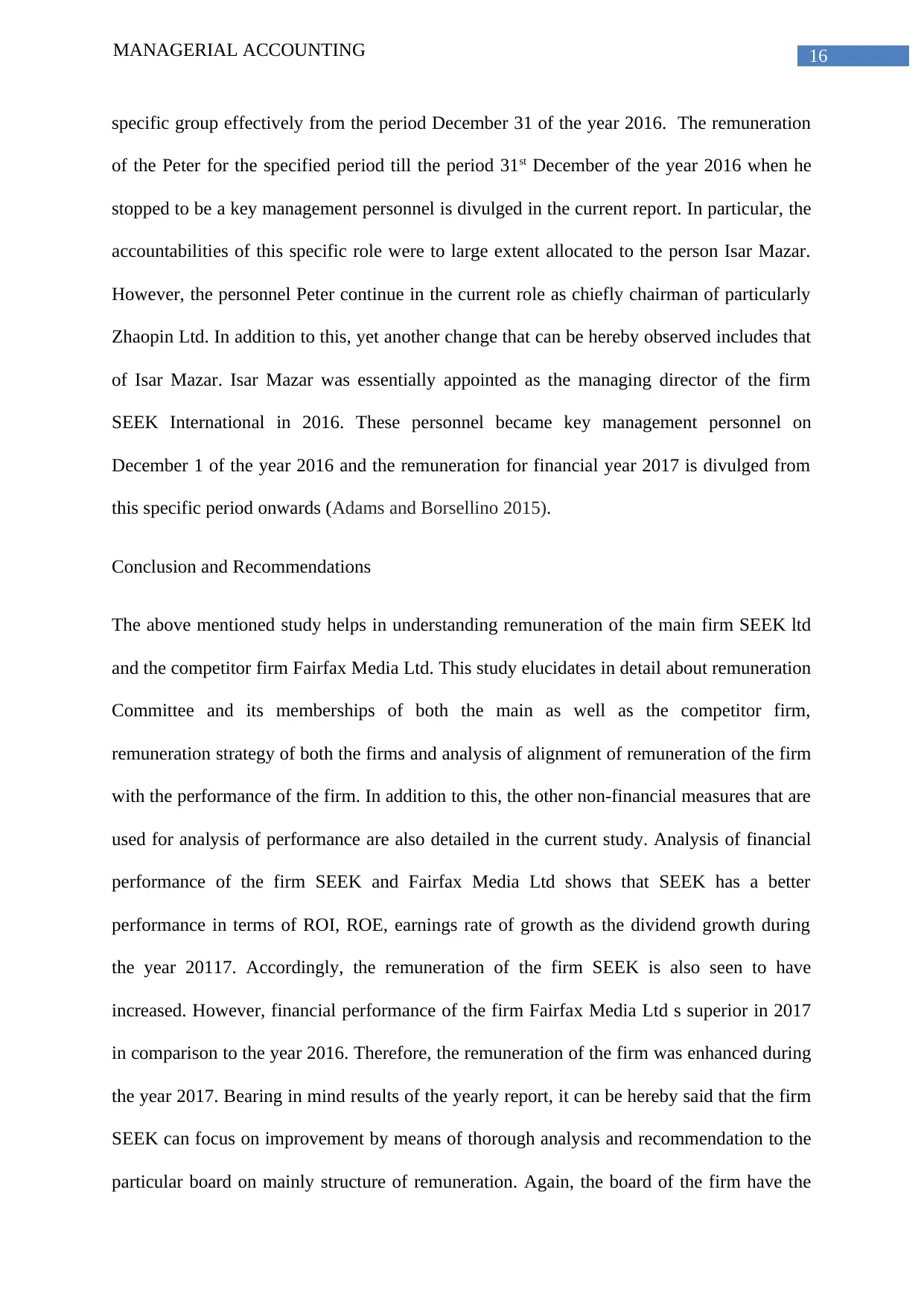
16MANAGERIAL ACCOUNTING
specific group effectively from the period December 31 of the year 2016. The remuneration
of the Peter for the specified period till the period 31st December of the year 2016 when he
stopped to be a key management personnel is divulged in the current report. In particular, the
accountabilities of this specific role were to large extent allocated to the person Isar Mazar.
However, the personnel Peter continue in the current role as chiefly chairman of particularly
Zhaopin Ltd. In addition to this, yet another change that can be hereby observed includes that
of Isar Mazar. Isar Mazar was essentially appointed as the managing director of the firm
SEEK International in 2016. These personnel became key management personnel on
December 1 of the year 2016 and the remuneration for financial year 2017 is divulged from
this specific period onwards (Adams and Borsellino 2015).
Conclusion and Recommendations
The above mentioned study helps in understanding remuneration of the main firm SEEK ltd
and the competitor firm Fairfax Media Ltd. This study elucidates in detail about remuneration
Committee and its memberships of both the main as well as the competitor firm,
remuneration strategy of both the firms and analysis of alignment of remuneration of the firm
with the performance of the firm. In addition to this, the other non-financial measures that are
used for analysis of performance are also detailed in the current study. Analysis of financial
performance of the firm SEEK and Fairfax Media Ltd shows that SEEK has a better
performance in terms of ROI, ROE, earnings rate of growth as the dividend growth during
the year 20117. Accordingly, the remuneration of the firm SEEK is also seen to have
increased. However, financial performance of the firm Fairfax Media Ltd s superior in 2017
in comparison to the year 2016. Therefore, the remuneration of the firm was enhanced during
the year 2017. Bearing in mind results of the yearly report, it can be hereby said that the firm
SEEK can focus on improvement by means of thorough analysis and recommendation to the
particular board on mainly structure of remuneration. Again, the board of the firm have the
specific group effectively from the period December 31 of the year 2016. The remuneration
of the Peter for the specified period till the period 31st December of the year 2016 when he
stopped to be a key management personnel is divulged in the current report. In particular, the
accountabilities of this specific role were to large extent allocated to the person Isar Mazar.
However, the personnel Peter continue in the current role as chiefly chairman of particularly
Zhaopin Ltd. In addition to this, yet another change that can be hereby observed includes that
of Isar Mazar. Isar Mazar was essentially appointed as the managing director of the firm
SEEK International in 2016. These personnel became key management personnel on
December 1 of the year 2016 and the remuneration for financial year 2017 is divulged from
this specific period onwards (Adams and Borsellino 2015).
Conclusion and Recommendations
The above mentioned study helps in understanding remuneration of the main firm SEEK ltd
and the competitor firm Fairfax Media Ltd. This study elucidates in detail about remuneration
Committee and its memberships of both the main as well as the competitor firm,
remuneration strategy of both the firms and analysis of alignment of remuneration of the firm
with the performance of the firm. In addition to this, the other non-financial measures that are
used for analysis of performance are also detailed in the current study. Analysis of financial
performance of the firm SEEK and Fairfax Media Ltd shows that SEEK has a better
performance in terms of ROI, ROE, earnings rate of growth as the dividend growth during
the year 20117. Accordingly, the remuneration of the firm SEEK is also seen to have
increased. However, financial performance of the firm Fairfax Media Ltd s superior in 2017
in comparison to the year 2016. Therefore, the remuneration of the firm was enhanced during
the year 2017. Bearing in mind results of the yearly report, it can be hereby said that the firm
SEEK can focus on improvement by means of thorough analysis and recommendation to the
particular board on mainly structure of remuneration. Again, the board of the firm have the
Secure Best Marks with AI Grader
Need help grading? Try our AI Grader for instant feedback on your assignments.

17MANAGERIAL ACCOUNTING
need to make certain that framework of remuneration replicates concentration of the board
along with alignment of the firm SEEK. Also, there is need to make certain that level of
remuneration are essentially competitive and can attract qualified as well as experiences
executives as well as directors.
need to make certain that framework of remuneration replicates concentration of the board
along with alignment of the firm SEEK. Also, there is need to make certain that level of
remuneration are essentially competitive and can attract qualified as well as experiences
executives as well as directors.
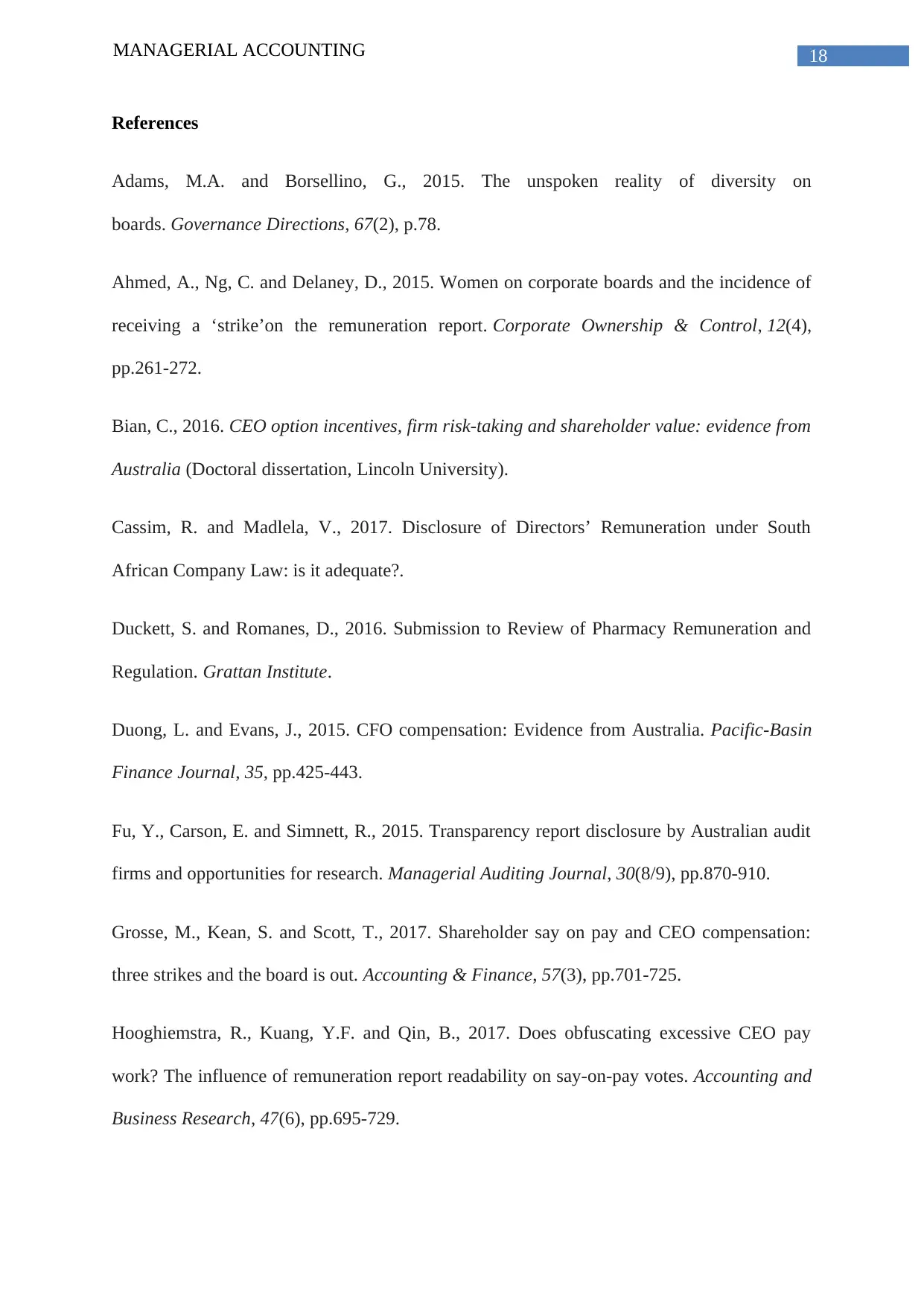
18MANAGERIAL ACCOUNTING
References
Adams, M.A. and Borsellino, G., 2015. The unspoken reality of diversity on
boards. Governance Directions, 67(2), p.78.
Ahmed, A., Ng, C. and Delaney, D., 2015. Women on corporate boards and the incidence of
receiving a ‘strike’on the remuneration report. Corporate Ownership & Control, 12(4),
pp.261-272.
Bian, C., 2016. CEO option incentives, firm risk-taking and shareholder value: evidence from
Australia (Doctoral dissertation, Lincoln University).
Cassim, R. and Madlela, V., 2017. Disclosure of Directors’ Remuneration under South
African Company Law: is it adequate?.
Duckett, S. and Romanes, D., 2016. Submission to Review of Pharmacy Remuneration and
Regulation. Grattan Institute.
Duong, L. and Evans, J., 2015. CFO compensation: Evidence from Australia. Pacific-Basin
Finance Journal, 35, pp.425-443.
Fu, Y., Carson, E. and Simnett, R., 2015. Transparency report disclosure by Australian audit
firms and opportunities for research. Managerial Auditing Journal, 30(8/9), pp.870-910.
Grosse, M., Kean, S. and Scott, T., 2017. Shareholder say on pay and CEO compensation:
three strikes and the board is out. Accounting & Finance, 57(3), pp.701-725.
Hooghiemstra, R., Kuang, Y.F. and Qin, B., 2017. Does obfuscating excessive CEO pay
work? The influence of remuneration report readability on say-on-pay votes. Accounting and
Business Research, 47(6), pp.695-729.
References
Adams, M.A. and Borsellino, G., 2015. The unspoken reality of diversity on
boards. Governance Directions, 67(2), p.78.
Ahmed, A., Ng, C. and Delaney, D., 2015. Women on corporate boards and the incidence of
receiving a ‘strike’on the remuneration report. Corporate Ownership & Control, 12(4),
pp.261-272.
Bian, C., 2016. CEO option incentives, firm risk-taking and shareholder value: evidence from
Australia (Doctoral dissertation, Lincoln University).
Cassim, R. and Madlela, V., 2017. Disclosure of Directors’ Remuneration under South
African Company Law: is it adequate?.
Duckett, S. and Romanes, D., 2016. Submission to Review of Pharmacy Remuneration and
Regulation. Grattan Institute.
Duong, L. and Evans, J., 2015. CFO compensation: Evidence from Australia. Pacific-Basin
Finance Journal, 35, pp.425-443.
Fu, Y., Carson, E. and Simnett, R., 2015. Transparency report disclosure by Australian audit
firms and opportunities for research. Managerial Auditing Journal, 30(8/9), pp.870-910.
Grosse, M., Kean, S. and Scott, T., 2017. Shareholder say on pay and CEO compensation:
three strikes and the board is out. Accounting & Finance, 57(3), pp.701-725.
Hooghiemstra, R., Kuang, Y.F. and Qin, B., 2017. Does obfuscating excessive CEO pay
work? The influence of remuneration report readability on say-on-pay votes. Accounting and
Business Research, 47(6), pp.695-729.

19MANAGERIAL ACCOUNTING
Kanapathippillai, S., Johl, S.K. and Wines, G., 2016. Remuneration committee effectiveness
and narrative remuneration disclosure. Pacific-Basin finance journal, 40, pp.384-402.
Maas, K. and Rosendaal, S., 2016. Sustainability targets in executive remuneration: Targets,
time frame, country and sector specification. Business Strategy and the Environment, 25(6),
pp.390-401.
Peetz, D., 2015. An institutional analysis of the growth of executive remuneration. Journal of
Industrial Relations, 57(5), pp.707-725.
Pottenger, M. and Leigh, A., 2016. Long‐Run Trends in Australian Executive Remuneration:
BHP, 1887–2012. Australian Economic History Review, 56(1), pp.2-20.
Riaz, Z., 2016. A hybrid of state regulation and self-regulation for remuneration governance
in Australia. Corporate Governance, 16(3), pp.539-563.
Riaz, Z., Ray, S., Ray, P.K. and Kumar, V., 2015. Disclosure practices of foreign and
domestic firms in Australia. Journal of World Business, 50(4), pp.781-792.
Safari, M., Cooper, B.J. and Dellaportas, S., 2016. The influence of remuneration structures
on financial reporting quality: evidence from Australia. Australian Accounting Review, 26(1),
pp.66-75.
Scholtz, H.E. and Engelbrecht, W.A., 2015. The effect of remuneration committees, directors'
shareholding and institutional ownership on the remuneration of directors in the top 100
companies in South Africa. Southern African Business Review, 19(Special edition 2), pp.22-
51.
Steele, S., Chen, V. and Ramsay, I., 2016. An empirical study of Australian judicial decisions
relating to insolvency practitioner remuneration.
Kanapathippillai, S., Johl, S.K. and Wines, G., 2016. Remuneration committee effectiveness
and narrative remuneration disclosure. Pacific-Basin finance journal, 40, pp.384-402.
Maas, K. and Rosendaal, S., 2016. Sustainability targets in executive remuneration: Targets,
time frame, country and sector specification. Business Strategy and the Environment, 25(6),
pp.390-401.
Peetz, D., 2015. An institutional analysis of the growth of executive remuneration. Journal of
Industrial Relations, 57(5), pp.707-725.
Pottenger, M. and Leigh, A., 2016. Long‐Run Trends in Australian Executive Remuneration:
BHP, 1887–2012. Australian Economic History Review, 56(1), pp.2-20.
Riaz, Z., 2016. A hybrid of state regulation and self-regulation for remuneration governance
in Australia. Corporate Governance, 16(3), pp.539-563.
Riaz, Z., Ray, S., Ray, P.K. and Kumar, V., 2015. Disclosure practices of foreign and
domestic firms in Australia. Journal of World Business, 50(4), pp.781-792.
Safari, M., Cooper, B.J. and Dellaportas, S., 2016. The influence of remuneration structures
on financial reporting quality: evidence from Australia. Australian Accounting Review, 26(1),
pp.66-75.
Scholtz, H.E. and Engelbrecht, W.A., 2015. The effect of remuneration committees, directors'
shareholding and institutional ownership on the remuneration of directors in the top 100
companies in South Africa. Southern African Business Review, 19(Special edition 2), pp.22-
51.
Steele, S., Chen, V. and Ramsay, I., 2016. An empirical study of Australian judicial decisions
relating to insolvency practitioner remuneration.
1 out of 19
Related Documents
Your All-in-One AI-Powered Toolkit for Academic Success.
+13062052269
info@desklib.com
Available 24*7 on WhatsApp / Email
![[object Object]](/_next/static/media/star-bottom.7253800d.svg)
Unlock your academic potential
© 2024 | Zucol Services PVT LTD | All rights reserved.





